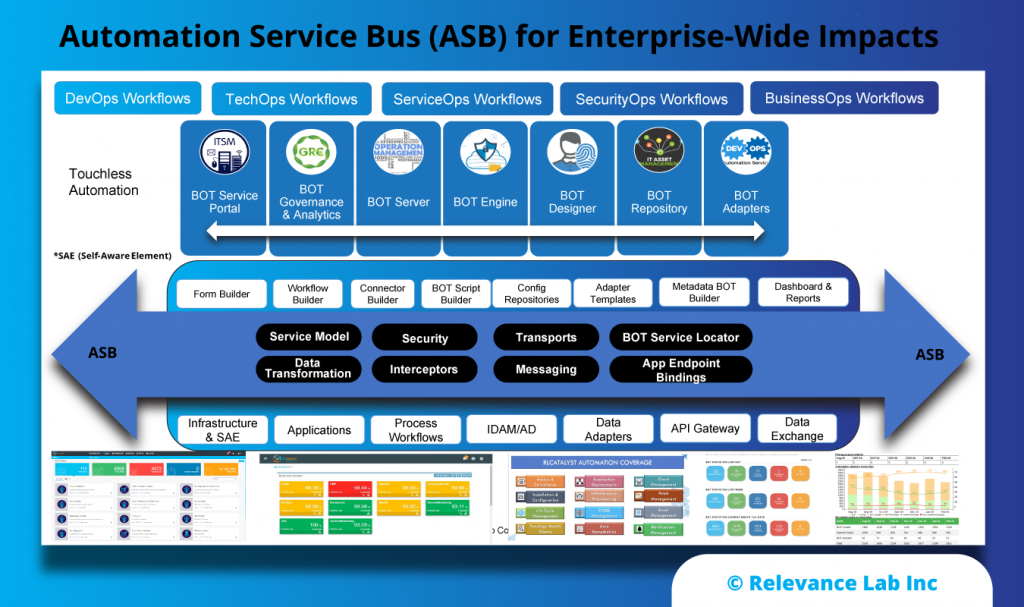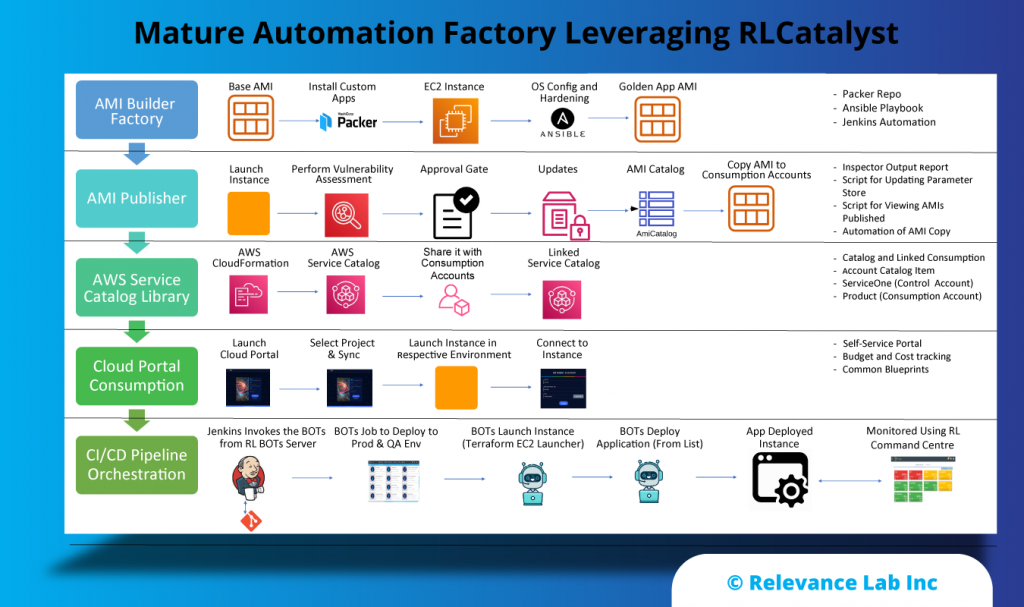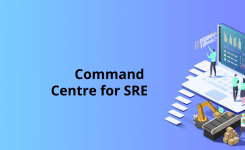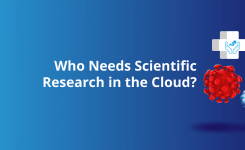2021 Blog, BOTs Blog, Blog, Featured
Get Started with Building Your Automation Factory for Cloud
While helping our customers with the right way to use the cloud using an Automation-First approach, the primary focus from Relevance Lab is to enable significant automation (achieved 70%+ for large customers) of day-to-day tasks with benefits on the speed of delivery, quality improvements, and cost reduction. Large customers have complex organizational structures with different groups focussing on infrastructure automation, application deployment automation, and service delivery automation. In many cases, there is a missing common architecture in planning, building, and running a proper end-to-end automation program. To help enterprises adopt an Automation-First approach for cloud adoption covering all three aspects of infrastructure, applications, and service delivery, we help create a blueprint for an Automation Factory.
In this blog, we are sharing our approach for large customers with a complex landscape of infrastructure and applications. The focus of this blog is more on application deployment automation with custom and COTS (commercial off-the-shelf) products in Cloud.
Some of the most typical asks by customers with all their workloads in AWS Cloud is captured below:
- Separation of roles between common infrastructure teams and multiple business units managing their own application needs
- Infrastructure teams provide base AMI with CloudFormation stacks to provide basic OS-level compute workloads to application groups, who manage their own deployments
- Application groups deal with a set of custom Java + .NET applications and COTS products, including Oracle Fusion Middleware stacks
- Application groups manage the complete lifecycle of deployment and support in production environments
- Application deployments are about 20% containerized and 80% direct installations in hybrid scenarios with legacy codebases
- Different set of tools are used along with homegrown custom scripts
- Primary pain points are to automate application and product (COTS) build and deploy lifecycle across different environments and upgrades
- The solution is expected to leverage DevOps maturity and automation-led standardization for speed and flexibility
- Need guidance on the choice of Automation Factory model between mutable vs. immutable designs
Key requirements from application groups are shared below based on the snapshot of products for which there is a need for automated installation and scalability at run-time. The shift needs to happen from “handcrafting” product installations to automated and easy deployment, preferably with immutable infrastructure.
| Standard Products | COTS Products (High Priority) | COTS Products (Good to have) |
|---|---|---|
| Weblogic | Oracle E-Business Suite (Financial Portal) | Cisco UCM |
| Tomcat 7, 8, & 9 | OBIEE | Kofax |
| Apache | Oracle Discoverer | IBM Business Rules Engine |
| IIS 10 | Oracle Siebel CRM | Aspect |
| Oracle 19 | Microsoft SQL Server Reporting Service | Avaya |
| SQL Server | Oracle Fusion | AS/400 Apps |
| MS SQL | SAP Enterprise | Adobe AEM |
Relevance Lab Approach for Hyperautomation with RLCatalyst and BOTs
Our teams have implemented 50+ engagements across customers and created a mature automation framework to help re-use and speed up the need for an Automation Factory using RLCatalyst BOTs and RLCatalyst Cloud Portals.
The figure below explains the RLCatalyst solutions for hyperautomation leveraging the Automation Service Bus (ASB) framework that allows easy integration with existing customer tools and cloud environments.

The key building block of automation depends on the concept of BOTs. So what are BOTs?
- BOTs are automation codes managed by Automation Service Bus orchestration
- Infrastructure creation, updation, deletion
- Application deployment lifecycle
- Operational services, tasks, and workflows – Check, Act, Sensors
- Interacting with Cloud and On-prem systems with integration adapters in a secure and auditable manner
- Targeting any repetitive Operations tasks managed by humans – frequently, complex (time-consuming), security/compliance related
- What are types of BOTs?
- Templates – CloudFormation, Terraform, Azure Resource Models, Service Catalog
- Lambda functions, Scripts (PowerShell/python/shell scripts)
- Chef/Puppet/Ansible configuration tools – Playbooks, Cookbooks, etc.
- API Functions (local and remote invocation capability)
- Workflows and state management
- UIBOTs (with UiPath, etc.) and un-assisted non-UI BOTs
- Custom orchestration layer with integration to Self-Service Portals and API Invocation
- Governance BOTs with guardrails – preventive and corrective
- What do BOTs have?
- Infra as a code stored in source code configuration (GitHub, etc.)
- Separation of Logic and Data
- Managed Lifecycle (BOTs Manager and BOTs Executors) for lifecycle support and error handling
- Intelligent Orchestration – Task, workflow, decisioning, AI/ML
Proposed Solution to Customers
There are different approaches to achieving end-to-end automation, and the right solution depends on a proper assessment of the context of customer needs. Relevance Lab follows a consultative approach that helps do a proper assessment of customer needs, priorities, and business goals to create the right foundation and suggest a maturity model for an Automation Factory. Also, different engagement models are offered to customers covering the entire phase of the Plan-Build-Run lifecycle of automation initiatives, including organization design and change management.
The following table helps plan the right approach and maturity model to be adopted for BOTs targeting different levels of complexity for automation.
| BOT Complexity | Functionality | Coverage | Leveraging Relevance Lab Products and Solutions |
|---|---|---|---|
| Level-1 | Standard Cloud Resources Provisioning in a secure, multi-account covering compute, storage and data | EC2 Linux, EC2 Win, S3 Buckets, RDS, SageMaker, ALB, EMR, VPC, etc. with AWS Service Catalog | AWS Console and ITSM Portals RLCatalyst Cloud Portal, BOTs Server CI/CD Pipelines with BOTs APIs |
| Level-2 | Standard Applications deployment covering Middleware, Databases, Open Source Applications requiring single node setup. Single Node COTS setups can also be included though more complex | Tomcat, Apache, MySQL, NGINX – common Middleware and Database Stacks |
Portal, CI/CD Pipeline, CLI
Variants: – Option-1 AMI Based (Preferred model for Immutable design) – Option- 2 Docker Based – Option- 3 Chef/Ansible Post Provision App Install & Configure (Mutable Design) BUILD Phase – Covering Plan, Build, Test, Publish Lifecycle CONSUME Phase – Production Deploy & Upgrade Lifecycle |
| Level-3 | Multi-tier Applications – 2-Tier, 3-Tier, N-Tier with Web + App + DB, etc. combinations | Required a combination of Infra, Apps, Post provision configurations, and orchestration. Complex Infra with ALB, PaaS Service Integrations | Orchestration engine and service discovery/registry Docker and Kubernetes clusters |
| Level-4 | Complex Business Apps – ERP, Oracle EBS, COTS, HPC Clusters – not supporting standard Catalog Items. | Complex workflows with integration to multiple Third-Party systems | UI or System Driven Custom Orchestration Flows and workflow modules Event-driven and state management Post provisioning complex integrations Pre-built BOTs Library |
Leveraging a combination of Relevance Lab products and solutions, we provide a mature Automation Factory blueprint to our customers, as shown below.

The above solution is built leveraging best practices from AWS Well-Architected framework and bringing in a combination of AWS tools and other third-party solutions like HashiCorp, Ansible, Docker, Kubernetes, etc. The key building blocks of the Automation Factory cover the following tools and concepts:
- AWS AMI Builder Factory and Golden AMI concept
- HashiCorp Packer Scripts
- OS and Hardening with Ansible
- Vulnerability Assessment and Patch Management
- AWS Inspector, AWS Parameter Store, AMI Catalog publishing, Multi-Account AWS Best Practices
- AWS Service Catalog, Multi-Account Governance, Master and Consumption accounts
- Self-Service Cloud Portals with guard-rails and automated fulfilment
- CI/CD Pipelines for non-user assisted workflows using RLCatalyst BOTs, Terraform Templates, Jenkins, Docker, and Kubernetes
- Monitoring and diagnostics with Observability tools like RLCatalyst Command Center
- Ongoing Governance, Cost Management, Lifecycle Management, Blue-Green Deployments, and Container Management
- Cloud Accounts, VPC Automation, AWS Control Tower, AWS Management, and Governance Lens Automation
Summary
The journey to adopting an Automation-First approach requires a strong foundation that our Automation Factory solution offers, saving at least 6 months of in-house efforts and about US$250K worth of savings for large customers annually. The BOTs deployed can scale up to provide productivity gains of 4-5 people full-time employees with other benefits of better fulfillment SLAs, quality, and compliance gains. In the case of COTS deployments, especially with Oracle stacks, our BOTs have reduced the time of deployments from a few weeks to a few hours.
To know more about how can we help your automation journey, feel free to contact marketing@relevancelab.com.
Reference Links
Considerations for AWS AMI Factory Design
AWS Well-Architected Best Practices
ASB – A New Approach for Intelligent and Touchless Automation


